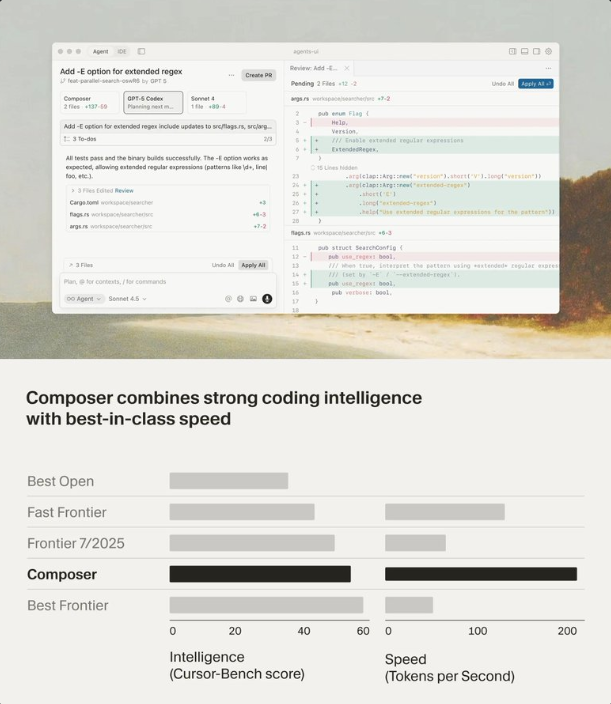While AI programming tools were still competing on single-completion accuracy, Cursor has quietly made a paradigm shift—from an "intelligent completion plugin" to a "multi-agent collaborative development platform." On October 29, 2025, the renowned AI code editor Cursor officially launched version 2.0, featuring its self-developed coding large model Composer and a revolutionary multi-Agent interface. It directly addresses delays, confusion, and single-threaded bottlenecks in complex project development, being hailed by the developer community as the "ultimate form of agent-based programming."

Composer: The Self-Developed Brain Designed for "Agent Coding"
The most significant breakthrough in Cursor 2.0 is its first self-developed model—Composer. Unlike previous versions that relied on GPT or Claude, Composer is specifically designed for low-latency, multi-step reasoning in agent-based coding (agentic coding). It uses a reinforcement learning (RL) + mixture of experts (MoE) architecture, combined with MXFP8 quantization training, achieving four times the response speed of similar models while maintaining high intelligence—most interactions are completed within 30 seconds, making the "think-execute-validate" loop smooth and seamless.
More importantly, Composer includes a semantic search engine at the codebase level, enabling it to accurately understand the context of millions of lines of code. This prevents "forgetting" or "confusion" when refactoring, debugging, or adding new features, solving the "disorientation" problem of large models in complex projects. Beta testers have called it "the most reliable AI pair programming partner."
Eight AI Agents Working in Parallel: Say Goodbye to Single-Threaded Development
Complementing Composer, Cursor 2.0 completely restructures the interface logic, shifting from a "file-centric" approach to a "agent-centric" one. Users can now launch up to eight independent AI agents simultaneously, each with its own workspace (based on Git worktrees or remote machines), operating without interference. For example:
- Agent 1 uses GPT-4 to plan the architecture,
- Agent 2 uses Claude Sonnet to write core algorithms,
- Agent 3 uses Composer to optimize performance,
- The final result is then merged by the developer.
This "multi-model + multi-task" parallel approach significantly improves the quality and robustness of complex features, especially suitable for enterprise-level projects.

Full-Process Automation: Review, Testing, and Execution Seamlessly Integrated
Cursor 2.0 also deeply integrates the entire development workflow:
- AI code review: automatically highlights changes and explains the intent behind modifications;
- Native browser (official version): Agents can read DOM in real-time and run front-end tests;
- Sandbox terminal (macOS official version): securely execute shell commands, avoiding accidental operations;
- Voice input + context-aware: Agents automatically collect error logs and related files, without manual pasting.
These features free developers from the tedious task of switching contexts, allowing them to focus entirely on business logic.
Strategic Upgrading: From Tool to Ecosystem, Cursor Regains the Initiative
This upgrade marks Cursor's strategic shift from a "third-party model integrator" to a "self-developed model + platform ecosystem." While competitors like GitHub Copilot and CodeWhisperer are still focused on point-efficiency improvements, Cursor has bet on the next-generation development paradigm of "multi-agent collaboration," building a technological moat.
Although the new interface requires a short adaptation period, early user feedback shows that Composer's speed advantage and the flexibility of multiple agents are quickly regaining developer trust. In today's era where AI programming has entered a new stage of "from writing code to managing AI," Cursor 2.0 is not just a product iteration but a deep restructuring of the developer workflow. In the future, your IDE may no longer be just an editor, but a "virtual development team" composed of multiple AI experts.
